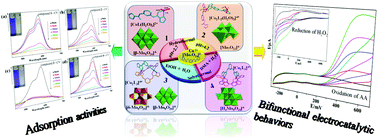Various polyoxomolybdate-based hybrids induced by pH and solvents: structures, adsorption activities for dyes and bifunctional electrocatalytic properties†
Abstract
By changing the pH values and solvents of reaction systems, four polyoxomolybdate-based compounds, [CoL(H2O)2][β-Mo8O26]0.5 (1), {[Co2L2(H2O)3][Mo7O23]}·3H2O (2), [Co2L3][δ-Mo8O26]0.5[β-Mo8O26]0.5·10H2O (3), [Co2L3][H4Mo8O28]·4DMA·2H2O (4), (L = 1,3-bis(1H-imidazole-4-carboxamido)metaphenylene, DMA = N,N‘-dimethylacetamide), have been synthesized in the presence of the Co2+ ion, L ligand and Mo7O246−. Compounds 1 and 2 were obtained under hydrothermal conditions; the different pH values result in two kinds of polyoxomolybdate anions, [β-Mo8O26]4− in 1 and [Mo14O46]8− in 2, and the similar [CoL(H2O)2]2+ or [Co2L2(H2O)3]4+ metal–organic chains. Compounds 3 and 4 were synthesized under mixed-solvent conditions. There are two kinds of octamolybdate isomers in 3, [β-Mo8O26]4− and [δ-Mo8O26]4− anions, but only one kind of [Mo8O28]8− anion in 4, but the two compounds have a similar metal–organic cage [Co2L3]4+. The results reveal that the pH values and different solvents play key roles in tuning the diverse architectures of polyoxomolybdate anions and metal–organic motifs. The adsorption activities for organic dyes, crystal violet (CV), methylene blue (MB) and Congo red (CR), and the electrocatalytic properties of hydrogen peroxide (H2O2) and ascorbic acid (AA) of compounds 1–4 are reported here.



 Please wait while we load your content...
Please wait while we load your content...